The 3-2-1 Column: What's required to win, Pa. recruiting and more
MORE HEADLINES - The Morning Pitt Mailbag: NIL, transfers and more | Speedy WR from Michigan talks Pitt offer | Three-pointers: The comeback win, Jeffress' impact and Pitt's most efficient half | Bell offers 2025 Fla. WR with expanding recruitment | Second-half energy leads Pitt's comeback effort against Wake
In this week's 3-2-1 Column, we're thinking about Pitt's comeback against Wake Forest, recruiting the state of Pennsylvania and a lot more.
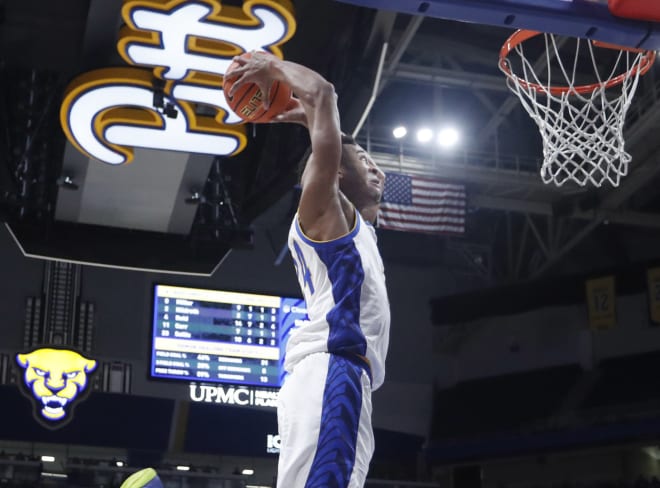
THREE THINGS WE KNOW
The Miami game helped Pitt win the Wake game
Jeff Capel had a lot to say after Pitt’s win over Wake Forest on Wednesday night and, as usual, there was a lot of good stuff in his remarks. But I thought this one quote was particularly interesting:
“We talked at halftime, and I told them, ‘You’ve played hard, but it requires harder. We’ve been physical, but we have to be more physical. This is what the game requires.’ And it’s a message that I’ve been trying to get us to understand, really, all year. Like, what’s required to win. And it was great to see us come out in the second half - really, all game, but especially in the second half - to go to a different level, to show ourselves that we can do that.”
I thought that quote was notable. It’s not necessarily the first time Capel has said things along those lines. He has talked for pretty much the last six years about his teams learning what it takes to win and what’s required to win.
Some teams got it and some teams didn’t.
Well, last year’s team got it. The previous four…not so much.
But that’s the lesson Capel has been trying to teach his team, and it seemed like they figured it out for one night, at least, when they came back from a 10-point halftime deficit to beat Wake Forest 77-72 at the Petersen Events Center on Wednesday.
After that game, I couldn’t help but wonder if the outcome - more specifically, the effort that produced it - was influenced, or at least impacted, by what happened four days earlier.
That was Pitt’s game at Miami, the finale in a three-game road trip that had already seen the Panthers knock off Duke and Georgia Tech. But they fell behind as the Hurricanes built an 11-point lead at halftime that stretched to 19 six minutes into the second half.
Plenty of teams - at Pitt and elsewhere - would have folded when facing such a deficit. Instead, the Panthers rallied. I don’t need to regale you with the details, because you likely saw it, but the end result was Pitt getting the lead down to two points in the final 45 seconds but failing to close out the comeback and losing by four.
A valiant effort that ultimately came up empty.
And while it came up empty for a variety of reasons, maybe those reasons can be lumped under the umbrella of the team not fully understanding “what’s required to win.”
And maybe one of the impacts of that loss was a greater understanding of “what’s required to win.”
As in, maybe a situation where falling short of the requirements can help paint a clearer picture of what those requirements really are.
Pitt got really, really close at Miami, and maybe on the flight home and in subsequent days, the players were able to reflect on how they got that close - and what they needed to do to not just get close but to actually finish the game.
Like Capel said, they played hard, but they needed to play harder.
They were physical, but they needed to be more physical.
They didn’t quite have enough of it at Miami, but they had it against Wake Forest, and maybe the difference between the two games will leave a lasting impression on Pitt’s players.
It wouldn’t be the worst thing if this team ends up having a turning point in the season. The Duke game will probably be the most obvious option, but maybe it will turn out to be the Miami game.
We’ll see.
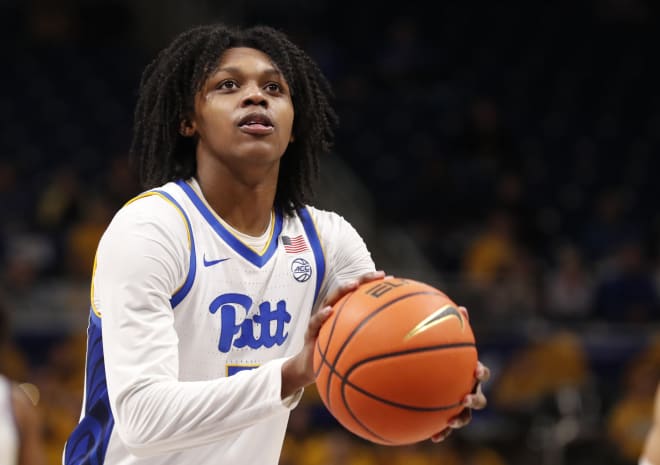
They keep pulling you back in
Or maybe they don’t. That’s up to you.
But it’s hard not to get caught up in this Pitt team.
They lose four out of five, three of which were at home, and then they go on the road to face Duke and pretty much control the game from the start. They slip up at Miami and look like they can’t stop digging holes too deep to climb out of, and then they do exactly that - climb out of a hole - against Wake Forest for their first home ACC win of the season.
And you’re left wondering: just who the heck are these guys?
The reality is, the answer to that question seems to change every night, and they’ve got a real Forrest Gump thing going on, because you never know what you’re going to get.
That’s not even just a night-to-night thing; it can happen on a half-to-half basis. That was certainly the case against Wake Forest and Miami. In both of those games, Pitt was pretty solidly outplayed in the first half, leading to a pair of double-digit halftime deficits. But somehow the Panthers improved considerably in the second halves of each of those games. The Panthers’ shooting percentage at Miami went up 10 points after halftime. Against Wake Forest, the jump was more than 16 points.
That’s a switch that should stay flipped to the ON position.
The problem is, you just never know which way the switch will be flipped in any given game (or half).
These players are capable of playing at a high level. They’ve shown as much, and they’ve shown it on both ends of the court. They have four guys who are capable of scoring at multiple levels, and when they set their minds to defend, they can really get after it on that end.
And that’s how they keep you hanging on, even if it’s tenuous. Because even the most negative among us, those convinced after every loss that victory will never come again - even they get caught up in the wins.
I think part of the reason is that when Pitt does things well, it looks natural. Like the scoring of Bub Carrington, Blake Hinson and Ishmael Leggett on Wednesday night - it looked very natural. It looked like they were doing what they were comfortable doing. Nobody played out of their minds; it was just three good basketball players making good basketball plays.
Then we get sucked in because we convince ourselves that if those guys could just do that a little more consistently, boy, they just might be able to win some games.
And that’s how they pull us back in. Even though we all recognize that this team is not nearly consistent enough to win enough to make something out of this season, it sure is tempting.
It’s tempting when Carrington hits those pull-up J’s.
It’s tempting when Hinson finds his spot and fires.
It’s tempting when Leggett finds a path to the basket again and again.
It’s tempting when Jaland Lowe, who had a rare-for-recent off game against Wake Forest, bursts to his left and finishes.
It’s oh so tempting to buy in again. To believe again. To conjure up whatever hope still exists for this team’s future. To think that they just might be able to put it together.
Until the next game.

The MVP
How many times can I write/talk about Will Jeffress?
All of the times. That’s how many.
Today will probably be the conclusion of this three-day Will Jeffress news cycle, but I have to say: the Erie native earned it.
Everybody who watched Wednesday night’s win over Wake Forest will certainly attest to that. What Jeffress did in the final eight minutes and 13 seconds was positively awe-inspiring.
Let’s set the scene (again):
As the clock ticked under nine minutes, Pitt had chipped Wake’s lead from 11 down to three, and Ishmael Leggett tied it with a shot from beyond the arc. The back-and-forth continued until the 8:13 mark, when Jeff Capel subbed Blake Hinson for Federiko Federiko, leaving Pitt with a smaller-than-usual lineup and raising the question: Who would defend Efton Reid?
Wake Forest’s starting center, formerly of LSU and Gonzaga (and almost Pitt), had been playing well, scoring 14 points and grabbing seven rebounds to that point in the game. Reid had scored a pair of buckets in the paint in the two minutes leading up to Capel’s sub, and he looked like he was going to be a problem for the final eight minutes.
That is, until Jeffress got his hands on him.
Literally.
I’m sure we were all watching with curiosity on that first Wake Forest possession after Jeffress took the defensive assignment - “Jeffress guarding Reid? How is that going to go?” - and what I saw piqued my interest more than I expected:
Jeffress got physical with Reid. Despite giving up five inches in their listed heights, Jeffress went right at Reid, pushing him, shoving him, leaning on him and generally being a pest. Like that fruit fly that won’t stop buzzing around your head, except this time it’s a fruit fly that weighs like 230 pounds and is strong and keeps crashing into you.
That was a new experience for Reid, who had been having his way with Pitt’s centers up to that point and likely would have continued doing so.
But with Jeffress activated, Reid was effectively neutralized. Never mind scoring; Reid didn’t even attempt a field goal in the final eight minutes and had maybe one touch on a pass into the post, which he quickly returned to the perimeter when realizing there was a Wall of Will behind him.
Reid’s stat line in that 8:13 with Jeffress was guarding him tells the story:
0/0 field goals, 3 rebounds, 2 fouls, 1 turnover
And those three rebounds all basically came on the same possession in the final minute.
Neutralized.
We’ve gone over this about 100 times since Wednesday night, but Jeffress really was the key in the victory. I know, Pitt had two guys score in the 20’s, but I really don’t think the Panthers win if Jeffress doesn’t shut down Reid like that. Reid wasn’t going to be stopped by Federiko or Guillermo Diaz Graham; if those two continued attempting to defend him in the final eight minutes, it’s not inconceivable that he could have carried the Deacons to a win and probably scored 20+ points.
But with Reid taken out of the equation, Wake Forest’s path got a lot harder, and it was made even more so by the increased defensive energy from the rest of Pitt’s players.
I can tie Jeffress into that, too:
The other four guys on the court fed off of the energy Jeffress brought. They defended better and harder because they saw how hard he was working on Reid.
Jeffress hasn’t been getting a lot of opportunities lately; he played a total of seven minutes in the three games prior to Wednesday night. But he got a chance to do something unique against Wake Forest, and he more than delivered.
Maybe he should get the call defending centers more often. It wouldn’t be the craziest idea, and it certainly worked this week.
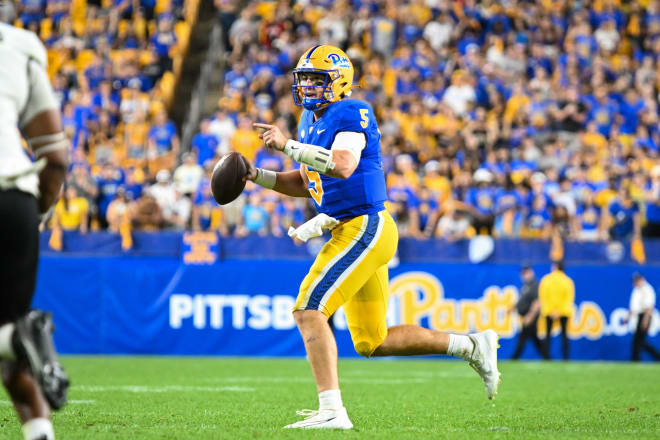
TWO QUESTIONS WE HAVE
Where have all the quarterbacks gone?
Earlier this week, I was doing some research on the states where Pitt recruits, and as an offshoot of that, I was looking at what states produced Pitt’s top players this century.
Where have the Panthers’ leaders in passing, rushing and receiver come from since 2000?
Not surprisingly, a whole lot of them came from out of state. We can talk more about that in a moment, but one thing did surprise me.
The quarterbacks.
Because in 14 out of the last 24 seasons from 2000 through 2023, Pitt started a Pennsylvania native.
Without thinking about the names, I was kind of shocked by that.
But then I looked at who those guys were - and how many years they started - and it added up. From Rod Rutherford in 2002 up to Phil Jurkovec this past season, Pitt has had nine different quarterbacks from Pennsylvania start games. Most started for full seasons; some (like the aforementioned Jurkovec) started a few games. Either way, there were a lot of in-state products leading Pitt’s offenses this century.
There was a particularly impressive run starting with Rutherford. He had two years at the helm (2002-03). Then Tyler Palko took over for three years (2004-06). Then Bill Stull, Pat Bostick and Kevan Smith were the starters in 2007 and Stull held the job in 2008 and 2009. The Tino Sunseri era came after that for three years, and Tom Savage had the job in 2013.
The run ended there, but that’s 12 years in a row where Pitt’s starting quarterback was an in-state product. Even more remarkably, a western Pa. native started in 11 of those 12 seasons (Savage was the exception).
And here is the point where we arrive at a discussion we’ve had many times before:
The dwindling local talent.
There simply haven’t been many Power Five quarterbacks to come out of western Pennsylvania in recent years. In the 10 recruiting classes that Pat Narduzzi has signed at Pitt, there have been just three:
DiNucci, Jurkovec and Julian Dugger, who signed with Pitt out of Penn Hills in the 2024 recruiting class.
Three over 10 classes? That’s pretty bad and the cutoff point happened around 2014 or so. Before DiNucci in the 2015 class, there was Chavas Rawlins from Monessen; he signed with West Virginia in 2013. And there was Perry Hills from Central Catholic; he signed with Maryland in 2012 (and actually played a decent amount).
There was Paul Jones in the 2010 class; he went to Penn State from Sto-Rox. Seneca Valley’s C.J. Brown signed with Maryland in 2009. Terrelle Pryor went to Ohio State from Jeannette in 2008 (Sunseri signed with Pitt that same year). Conner Dixon in 2006 went to Michigan State from South Park (Kevan Smith signed with Pitt that year).
So in 10 recruiting classes from 2006-13, there were eight quarterbacks from western Pa. who signed with power conference teams; in the next 10 recruiting classes, there were three.
And there were some decent college careers among those 10. C.J. Brown threw for 5,372 yards and 33 touchdowns in three active seasons at Maryland. Hills had a solid senior season with the Terrapins, too. Pryor’s career never lived up to the hype of his recruitment, but he did account for 74 touchdowns in three seasons.
But that’s beside the point. The point is the numbers, and like so many things in western Pa., the numbers at quarterback have dropped in the last 10 years. Could there be a resurgence? It’s possible, but chances are, Narduzzi and company will have to continue looking outside the region - and outside the state - for their quarterbacks going forward.
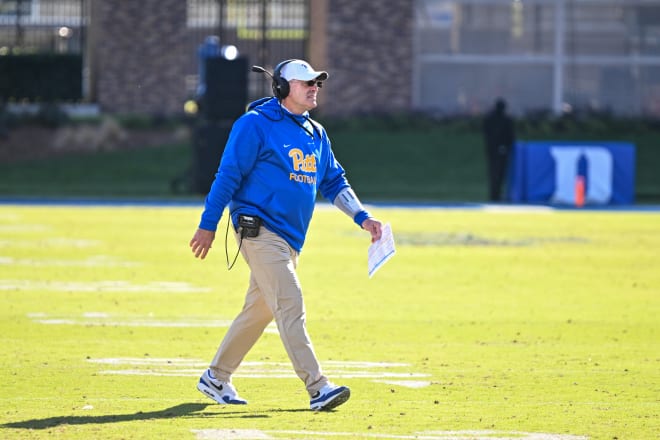
Did Narduzzi shift the emphasis?
Of course, it’s not just the quarterback position where Pitt has been looking for help from outside the state.
If you list the Panthers’ top producers from the last nine seasons, there’s a clear and observable trend:
More and more, they’re not products of Pennsylvania.
You don’t even need the numbers, really; just do a quick mental check:
Right now, in your head, name the top players at Pitt under Narduzzi.
I’m guessing the first name - probably names - that came to mind are from out of state, right?
Like the two first-round picks that Pitt has produced under Narduzzi: Kenny Pickett and Calijah Kancey. New Jersey and Florida.
Or pretty much anybody else who has been a top producer for Pitt in the last few years. The last time the Panthers were led in rushing by an in-state player was James Conner in 2016. The last time they had a Pennsylvanian lead them in receiving was Tyler Boyd in 2015.
Defensively, there has been more of a local influence, with guys like Damar Hamlin, Jordan Whitehead, Paris Ford, Dane Jackson, M.J. Devonshire and Donovan McMillon all leading the charge.
But for every one of them, there’s a Kancey or a SirVocea Dennis or a Damarri Mathis or a Jason Pinnock or a Marquis Williams or a Rashad Weaver or a Patrick Jones.
The list goes on and on, and the longer the list goes, the fewer Pennsylvanians show up on it.
Part of this is natural: few teams can build their entire rosters with in-state players. Even the best teams in Florida or Georgia or Texas or California can’t really get enough of the talent in their states to keep homegrown players at the top of the stat sheet. Everybody brings in players from out of state.
But what’s interesting to me is how things have shifted over the last nine years. I mentioned Conner and Boyd - those guys were on the roster in Narduzzi’s first two seasons (Boyd in 2015; Conner in 2015 and 2016). Whitehead and Dane Jackson were in the 2015 recruiting class. Hamlin came in the next year. Ford came a year after that. Devonshire and McMillon were later additions - both from the transfer portal - but I think you can see a trend:
Pitt has been getting less and less production from local and in-state recruits over the course of the Narduzzi era.
It’s not a matter of taking fewer guys from the state. In nine classes under Narduzzi, Pitt has signed 41 players from Pennsylvania; that’s more than any other state (although Florida is right behind with 40).
Rather, it’s more about where Pitt’s best players are coming from. And whether Narduzzi did it intentionally or not, those best players - particularly on offense - are coming from somewhere other than the Keystone State.
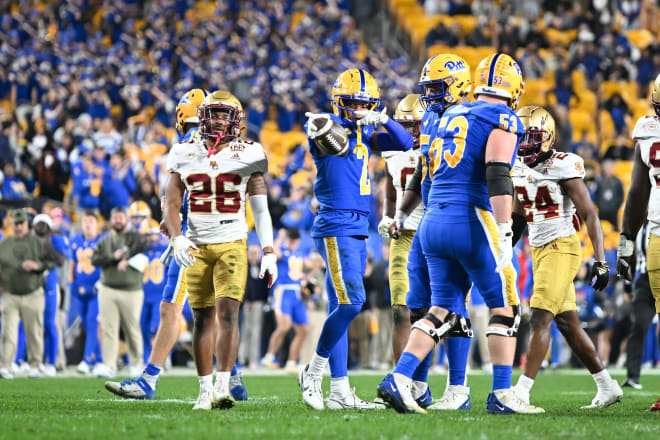
ONE PREDICTION
It’s gonna happen again
I’m not going out on a limb here, but it seems like a natural continuation from the last section of the column.
Pitt’s top producers on offense last season were all from out of state, and it’s going to happen again in 2024.
To some extent, this is going to play out because there aren’t a ton of options. Last year, there was a possibility that Pitt’s leading passer would be from Pennsylvania for the first time since 2017, but the Phil Jurkovec Experience didn’t exactly work out, so Christian Veilleux ended up leading the team in passing yards and passing touchdowns.
Now for 2024, there is only one in-state player on scholarship at quarterback, and that’s freshman Julian Dugger.
At running back, there are more options: redshirt junior Derrick Davis and true freshman Juelz Goff are both from Pennsylvania.
But at receiver, there’s only one: Kenny Johnson. And while he’s a dark horse candidate to be the leader in that position group this season, it seems like a safer bet to wager on Konata Mumpfield.
So at the three key skill position groups, there are four scholarship players, and unless there are significant injuries, it seems like maybe one of those four has a legitimate chance to lead the team in his position’s primary stat categories.
Expanding beyond the skill positions doesn’t help the situation much. Gavin Bartholomew is the obvious exception, but if you go to the offensive line, Pitt has three in-state players on scholarship; two are true freshmen and the other is Dorien Ford. That trio isn’t likely to see the field much this season.
So, at most, we’re talking about possibly two or three Pennsylvania natives contributing on offense this season (Derrick Davis remains intriguing to me, but who knows if he’ll break through with new running backs coach Lindsey Lamar).
Defense is a slightly different story. Dayon Hayes is a starter at end, and Sean FitzSimmons and Elliot Donald should be in the mix at tackle. Brandon George returned from the transfer portal and Braylan Lovelace will be in the linebacker rotation as a sophomore. And Donovan McMillon and Javon McIntyre should give the Panthers a pair of in-state players starting at safety again this season.
That’s a pretty decent group and a solid in-state influence on the defense.
Offensively, though, I don’t see a lot coming from the few Pennsylvania players Pitt has.
